
John Ronald Reuel Tolkien was born in Bloemfontein, South Africa, on January 3, 1892. In his youth, he took an interest in constructed language, studied Latin and Anglo-Saxon, and went on to attend Exeter College, Oxford. After finishing his degree, he enlisted in the British Army, was transported to France, and participated in the Battle of Somme before contracting trench fever and returning to England. Between his recurring illness and garrison duties, Tolkien worked on The Book of Lost Tales, including the story The Fall of Gondolin. Tolkien was taken off active service in 1919 and left the army in 1920.
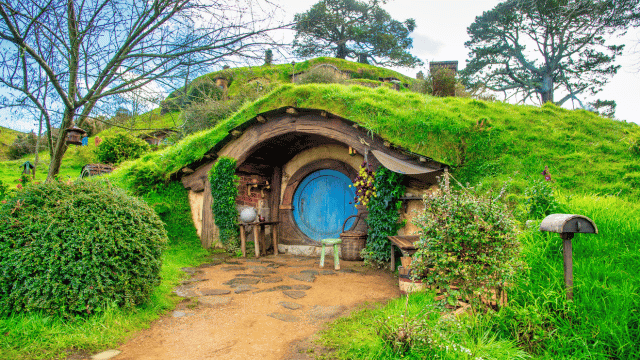
As a civilian, Tolkien took up a job at the Oxford English Dictionary, working on the history and etymology of W-words of Germanic origin. He became a member of the academic staff at the University of Leeds, producing A Middle English Vocabulary and an edition of Sir Gawain and the Green Knight. He later returned to his alma mater at Oxford as Rawlinson and Bosworth Professor of Anglo-Saxon with a fellowship at Pembroke College. It was there he wrote The Hobbit and the first two volumes of The Lord of the Rings—the series J. R. R. Tolkien is best known for today.
The Tolkien Society, an "educational charity, literary society, and international fan club" founded in 1969 and based in the UK, invites all Tolkien fans to raise a toast on the author's birthday every year on Jan. 3 at 9 p.m. local time. This toast is inspired by Frodo of Tolkien's The Lord of the Rings who toasted his uncle Bilbo on his birthday each year after he left the Shire on his eleventy-first birthday.
So, in celebration of J. R. R. Tolkien's 133rd birthday, check out one or more of Tolkien's works, feast in hobbit fashion, and lift your glass to give a cheer to "The Professor!"
- Middle-Earth and Lands Beyond
- Image
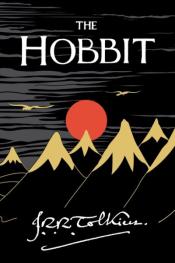
The Hobbit, or There and Back Again by J. R. R. Tolkien
In a hole in the ground, there lived a hobbit. Not a nasty, dirty, wet hole, filled with the ends of worms and an oozy smell, nor yet a dry, bare, sandy hole with nothing in it to sit down on or to eat: it was a hobbit hole, and that means comfort.
Written for J.R.R. Tolkien’s own children, The Hobbit met with instant critical acclaim when it was first published in 1937. Now recognized as a timeless classic, this introduction to the hobbit Bilbo Baggins, the wizard Gandalf, Gollum, and the spectacular world of Middle-earth recounts of the adventures of a reluctant hero, a powerful and dangerous ring, and the cruel dragon Smaug the Magnificent.
Image
The Fellowship of the Ring (The Lord of the Rings, Part 1) by J. R. R. Tolkien
One Ring to rule them all, One Ring to find them, One Ring to bring them all and in the darkness bind them.
In ancient times the Rings of Power were crafted by the Elven smiths, and Sauron, the Dark Lord, forged the One Ring, filling it with his own power so that he could rule all others. But the One Ring was taken from him, and though he sought it throughout Middle-earth, it remained lost to him. After many ages, it fell into the hands of Bilbo Baggins, as told in The Hobbit.
In a sleepy village in the Shire, young Frodo Baggins finds himself faced with an immense task, as his elderly cousin Bilbo entrusts the Ring to his care. Frodo must leave his home and make a perilous journey across Middle-earth to the Cracks of Doom, there to destroy the Ring and foil the Dark Lord in his evil purpose.
Image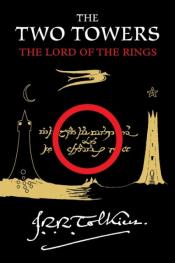
The Two Towers (The Lord of the Rings, Part 2) by J. R. R. Tolkien
Frodo and his Companions of the Ring have been beset by danger during their quest to prevent the Ruling Ring from falling into the hands of the Dark Lord by destroying it in the Cracks of Doom. They have lost the wizard, Gandalf, in a battle in the Mines of Moria. And Boromir, seduced by the power of the Ring, tried to seize it by force. While Frodo and Sam made their escape, the rest of the company was attacked by Orcs. Now they continue the journey alone down the great River Anduin—alone, that is, save for the mysterious creeping figure that follows wherever they go.
Image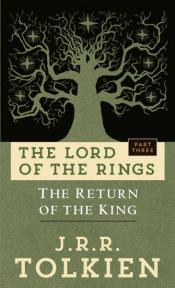
The Return of the King (The Lord of the Rings, Part 3) by by J. R. R. Tolkien
The Dark Lord has risen, and as he unleashes hordes of Orcs to conquer all Middle-earth, Frodo and Sam struggle deep into his realm in Mordor.
To defeat Sauron, the One Ring must be destroyed in the fires of Mount Doom. But the way is impossibly hard, and Frodo is weakening. The Ring corrupts all who bear it and Frodo’s time is running out.
Will Sam and Frodo succeed, or will the Dark Lord rule Middle-earth once more?
Image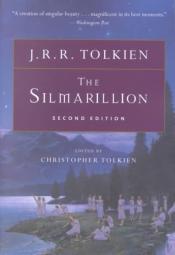
The Silmarillion by J. R. R. Tolkien
The Silmarillion is an account of the Elder Days, of the First Age of Tolkien’s world. It is the ancient drama to which the characters in The Lord of the Rings look back, and in whose events some of them such as Elrond and Galadriel took part. The tales of The Silmarillion are set in an age when Morgoth, the first Dark Lord, dwelt in Middle-Earth, and the High Elves made war upon him for the recovery of the Silmarils, the jewels containing the pure light of Valinor.
Image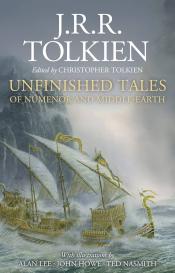
Unfinished Tales of Numenor and Middle-Earth by J. R. R. Tolkien
Unfinished Tales is a collection of narratives ranging in time from the Elder Days of Middle-earth to the end of the War of the Ring and provides those who have read The Lord of the Rings with a whole collection of background and new stories from the twentieth-century’s most acclaimed popular author.
The book concentrates on the realm of Middle-earth and comprises such elements as Gandalf’s lively account of how it was that he came to send the Dwarves to the celebrated party at Bag-End, the emergence of the sea-god Ulmo before the eyes of Tuor on the coast of Beleriand, and an exact description of the military organization of the Riders of Rohan.
Unfinished Tales also contains the only story about the long ages of Numenor before its downfall, and all that is known about such matters as the Five Wizards, the Palantiri, and the legend of Amroth. The tales were collated and edited by JRR Tolkien’s son and literary heir, Christopher Tolkien, who provides a short commentary on each story, helping the reader to fill in the gaps and put each story into the context of the rest of his father’s writings.
Image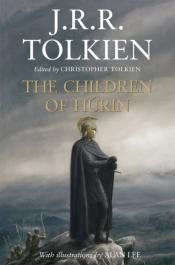
The Children of Húrin by J. R. R. Tolkien
This tale of Middle-earth's First Age, which appeared in incomplete forms in the posthumously published The Silmarillion and Unfinished Tales, also edited by Tolkien's son, Christopher, only hinted at the depth and power of the tragic story of Túrin and Niënor, the children of Húrin, the lord of Dor-lómin, who achieved renown for having confronted Morgoth, who was the master of Sauron, the manifestation of evil in the Lord of the Rings.
Six thousand years before the One Ring is destroyed, Middle-earth lies under the shadow of the Dark Lord Morgoth. The greatest warriors among elves and men have perished, and all is in darkness and despair. But a deadly new leader rises, Túrin, son of Húrin, and with his grim band of outlaws begins to turn the tide in the war for Middle-earth—awaiting the day he confronts his destiny and the deadly curse laid upon him.
Image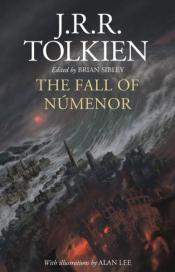
The Fall of Numenor by J. R. R. Tolkien
J.R.R. Tolkien’s writings on the Second Age of Middle-earth, collected for the first time in one volume.
J.R.R. Tolkien famously described the Second Age of Middle-earth as a ‘dark age, and not very much of its history is (or need be) told’. And for many years readers would need to be content with the tantalizing glimpses of it found within the pages of The Lord of the Rings and its appendices, including the forging of the Rings of Power, the building of the Barad-dûr and the rise of Sauron.
It was not until Christopher Tolkien published The Silmarillion after his father’s death that a fuller story could be told. Although much of the book’s content concerned the First Age of Middle-earth, there were at its close two key works that revealed the tumultuous events concerning the rise and fall of the island of Númenor. Raised out of the Great Sea and gifted to the Men of Middle-earth as a reward for aiding the angelic Valar and the Elves in the defeat and capture of the Dark Lord Morgoth, the kingdom became a seat of influence and wealth; but as the Númenóreans’ power increased, the seed of their downfall would inevitably be sown, culminating in the Last Alliance of Elves and Men.
Even greater insight into the Second Age would be revealed in subsequent publications, first in Unfinished Tales of Númenor and Middle-earth, then expanded upon in Christopher Tolkien’s magisterial twelve-volume The History of Middle-earth, in which he presented and discussed a wealth of further tales written by his father, many in draft form.
Now, adhering to the timeline of ‘The Tale of Years’ in the appendices to The Lord of the Rings, editor Brian Sibley has assembled into one comprehensive volume a new chronicle of the Second Age of Middle-earth, told substantially in the words of J.R.R. Tolkien from the various published texts, with new pencil illustrations by the doyen of Tolkien art, Alan Lee.
Image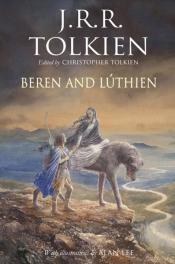
Beren and Lúthien by J. R. R. Tolkien
The tale of Beren and Lúthien was, or became, an essential element in the evolution of The Silmarillion, the myths and legends of the First Age of the World conceived by J.R.R. Tolkien. Returning from France and the battle of the Somme at the end of 1916, he wrote the tale in the following year.
Essential to the story, and never changed, is the fate that shadowed the love of Beren and Lúthien: for Beren was a mortal man, but Lúthien was an immortal elf. Her father, a great elvish lord, in deep opposition to Beren, imposed on him an impossible task that he must perform before he might wed Lúthien. This is the kernel of the legend; and it leads to the supremely heroic attempt of Beren and Lúthien together to rob the greatest of all evil beings, Melkor, called Morgoth, the Black Enemy, of a Silmaril.
In this book, Christopher Tolkien has attempted to extract the story of Beren and Lúthien from the comprehensive work in which it was embedded, but that story was itself changing as it developed new associations within the larger history. To show something of the process whereby this legend of Middle-earth evolved over the years, he has told the story in his father's own words by giving, first, its original form, and then passages in prose and verse from later texts that illustrate the narrative as it changed. Presented together for the first time, they reveal aspects of the story, both in event and in narrative immediacy, that were afterward lost.
Image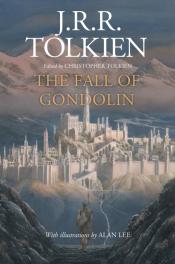
The Fall of Gondolin by J. R. R. Tolkien
In the Tale of The Fall of Gondolin are two of the greatest powers in the world. There is Morgoth of the uttermost evil, unseen in this story but ruling over a vast military power from his fortress of Angband. Deeply opposed to Morgoth is Ulmo, second in might only to Manwë, chief of the Valar: he is called the Lord of Waters, of all seas, lakes, and rivers under the sky. But he works in secret in Middle-earth to support the Noldor, the kindred of the Elves among whom were numbered Húrin and Túrin Turambar.
Central to this enmity of the gods is the city of Gondolin, beautiful but undiscoverable. It was built and peopled by Noldorin Elves who, when they dwelt in Valinor, the land of the gods, rebelled against their rule and fled to Middle-earth. Turgon King of Gondolin is hated and feared above all his enemies by Morgoth, who seeks in vain to discover the marvelously hidden city, while the gods in Valinor in heated debate largely refuse to intervene in support of Ulmo’s desires and designs.
Into this world comes Tuor, cousin of Túrin, the instrument of Ulmo’s designs. Guided unseen by him Tuor sets out from the land of his birth on the fearful journey to Gondolin, and in one of the most arresting moments in the history of Middle-earth the sea-god himself appears to him, rising out of the ocean in the midst of a storm. In Gondolin he becomes great; he is wedded to Idril, Turgon’s daughter, and their son is Eärendel, whose birth and profound importance in days to come is foreseen by Ulmo.
At last comes the terrible ending. Morgoth learns through an act of supreme treachery all that he needs to mount a devastating attack on the city, with Balrogs and dragons and numberless Orcs. After a minutely observed account of the fall of Gondolin, the tale ends with the escape of Túrin and Idril, with the child Eärendel, looking back from a cleft in the mountains as they flee southward, at the blazing wreckage of their city. They were journeying into a new story, the Tale of Eärendel, which Tolkien never wrote, but which is sketched out in this book from other sources.
Image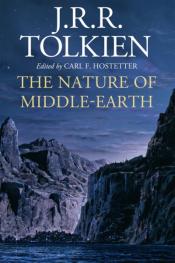
It is well known that J.R.R. Tolkien published The Hobbit in 1937 and The Lord of the Rings in 1954–5. What may be less known is that he continued to write about Middle-earth in the decades that followed, right up until the years before his death in 1973.
For him, Middle-earth was part of an entire world to be explored, and the writings in The Nature of Middle-earth reveal the journeys that he took as he sought to better understand his unique creation. From sweeping themes as profound as Elvish immortality and reincarnation, and the Powers of the Valar, to the more earth-bound subjects of the lands and beasts of Númenor, the geography of the Rivers and Beacon-hills of Gondor, and even who had beards!
This new collection, which has been edited by Carl F Hostetter, one of the world’s leading Tolkien experts, is a veritable treasure-trove offering readers a chance to peer over Professor Tolkien’s shoulder at the very moment of discovery: and on every page, Middle-earth is once again brought to extraordinary life.Image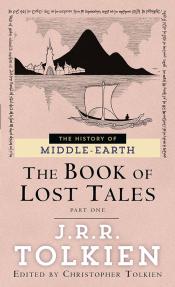
The Book of Lost Tales, Part One by J. R. R. Tolkien
The Book of Lost Tales 1 stands at the beginning of the entire conception of Middle-earth and Valinor. Embedded in English legend and English association, they were set in the narratve frame of a great westward voyage over the Ocean by a mariner named Eriol (or Ælfwine) to Tol Eressëa, the Lonely Isle, where Elves dwelt; from them he learned their true story, the Lost Tales of Elfinesse. In the Tales are found the earliest accounts and original ideas of Gods and Elves; Dwarves and Orcs; the Silmarils and the Two Trees of Valinor; Nargothrond and Gondolin; and the geography and cosmology of the invented world.
Image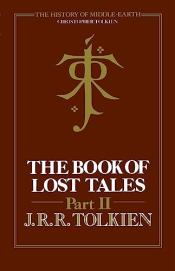
The Book of Lost Tales, Part Two by J. R. R. Tolkien
The Book of Lost Tales was the first major work of imagination by J.R.R. Tolkien, begun in 1916, when he was twenty-five years old, and left incomplete several years later. It stands at the beginning of the entire conception of Middle-earth and Valinor, for the Lost Tales were the first form of the myths and legends that came to be called The Silmarillion. Embedded in English legend and association, they are set in the narrative frame of the great westward voyage of a mariner named Eriel (or AElfwine). His destination is Tol Eressea, the Lonely Isle where Elves dwell; from them he learns their true history, the Lost Tales of Elfinesse. The Tales include the earliest accounts of Gods and Elves, Dwarves, Balrogs, and Orcs; of the Silmarils and the Two Trees of Valinor; of Nargothrond and Gondolin; of the geography and cosmography of their invented world. The Book of Lost Tales is published in two volumes. The first contains the Tales of Valinor; and this second past includes Beren and Luthien, Turin and the Dragon, and the only full narratives of the Necklace of the Dwarves and the Fall of Gondolin.
Each tale is followed by a commentary, together with associated poems, and each volume contains extensive information on names and vocabulary of the earliest Elvish languages. Additional books in this series will extend the history of Middle-earth as it was refined and enlarged in later years and will include the long Lays of Beleriand, the Ambarkanta or Shape of the World, the Lhammas or Account of Tongues, annals, maps, and many other previously unpublished writings of J.R.R. Tolkien
Image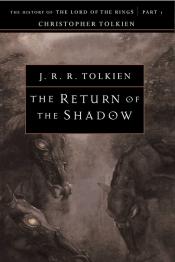
The Return of Shadow: The History of The Lord of the Rings, Part One by J. R. R. Tolkien
In this sixth volume of The History of Middle-earth the story reaches The Lord of the Rings. In The Return of the Shadow (an abandoned title for the first volume) Christopher Tolkien describes, with full citation of the earliest notes, outline plans, and narrative drafts, the intricate evolution of The Fellowship of the Ring and the gradual emergence of the conceptions that transformed what J.R.R. Tolkien for long believed would be a far shorter book, 'a sequel to The Hobbit'. The enlargement of Bilbo's 'magic ring' into the supremely potent and dangerous Ruling Ring of the Dark Lord is traced and the precise moment is seen when, in an astonishing and unforeseen leap in the earliest narrative, a Black Rider first rode into the Shire, his significance still unknown. The character of the hobbit called Trotter (afterwards Strider or Aragorn) is developed while his indentity remains an absolute puzzle, and the suspicion only very slowly becomes certainty that he must after all be a Man. The hobbits, Frodo's companions, undergo intricate permutations of name and personality, and other major figures appear in strange modes: a sinister Treebeard, in league with the Enemy, a ferocious and malevolent Farmer Maggot.
The story in this book ends at the point where J.R.R. Tolkien halted in the story for a long time, as the Company of the Ring, still lacking Legolas and Gimli, stood before the tomb of Balin in the Mines of Moria. The Return of the Shadow is illustrated with reproductions of the first maps and notable pages from the earliest manuscripts.
Image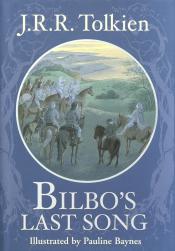
Bilbo's Last Song by J. R. R. Tolkien
A poem from "Lord of the Rings" and primary illustrations follow the hobbit Bilbo Baggins on his final journey to the Grey Havens, while secondary illustrations at the bottom of each page depict his first journey on adventure as recounted in "The Hobbit."
- More Fantasy
- Image
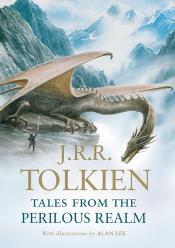
Tales from the Perilous Realm by J. R. R. Tolkien
The definitive collection of Tolkien’s classic “fairie” tales, in the vein of The Hobbit, illustrated by Oscar winner Alan Lee
Never before published in a single volume, Tolkien’s four novellas (Farmer Giles of Ham, Leaf by Niggle, Smith of Wootton Major, and Roverandom) and one book of poems (The Adventures of Tom Bombadil) are gathered together for the first time, in a fully illustrated volume. This definitive collection of works—which had appeared separately, in various formats, between 1949 and 1998—comes with a brand-new foreword and endmatter, and with a series of detailed pencil illustrations by Alan Lee, in the style of his other award-winning Tolkien work, most recently in The Children of Húrin.
The book is the perfect opportunity for fans of Middle-earth to enjoy some of Tolkien’s often overlooked yet most creative storytelling. With dragons and sand sorcerers, sea monsters and hobbits, knights and dwarves, this collection contains all the classic elements for Tolkien buffs of all ages.
Image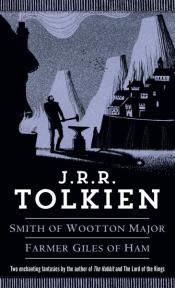
Smith of Wootton Major & Farmer Giles of Ham by J. R. R. Tolkien
Two bewitching fantasies by J.R.R. Tolkien, beloved author of THE HOBBIT. In SMITH OF WOOTTON MAJOR, Tolkien explores the gift of fantasy, and what it means to the life and character of the man who receives it. And FARMER GILES OF HAM tells a delightfully ribald mock-heroic tale, where a dragon who invades a town refuses to fight, and a farmer is chosen to slay him.
Farmer Giles of Ham first published in 1949. Smith of Wootton Major was first published in November 1965.
Image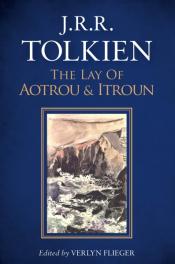
The Lay of Aotrou and Itroun by J. R. R. Tolkien
Set 'In Britain's land beyond the seas' during the Age of Chivalry, The Lay of Aotrou and Itroun tells of a childless Breton Lord and Lady (the 'Aotrou' and 'Itroun' of the title) and the tragedy that befalls them when Aotrou seeks to remedy their situation with the aid of a magic potion obtained from a corrigan, or malevolent fairy. When the potion succeeds and Itroun bears twins, the corrigan returns seeking her fee, and Aotrou is forced to choose between betraying his marriage and losing his life.
Coming from the darker side of J.R.R. Tolkien's imagination, The Lay of Aotrou and Itroun, together with the two shorter 'Corrigan' poems that lead up to it and which are also included, was the outcome of a comparatively short but intense period in Tolkien's life when he was deeply engaged with Celtic, and particularly Breton, myth and legend.
Originally written in 1930 and long out of print, this early but seminal work is an important addition to the non-Middle-earth portion of his canon and should be set alongside Tolkien's other retellings of myth and legend, The Legend of Sigurd and Gudrún, The Fall of Arthur and The Story of Kullervo. Like these works, it belongs to a small but important corpus of his ventures into 'real-world' mythologies, each of which in its own way would be a formative influence on his own legendarium.
Image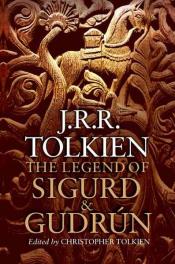
The Legend of Sigurd and Gudrun by J. R. R. Tolkien
In the "Lay of the Völsungs" is told the ancestry of the great hero Sigurd, the slayer of Fáfnir most celebrated of dragons, whose treasure he took for his own; of his awakening of the Valkyrie Brynhild, who slept surrounded by a wall of fire, and of their betrothal; and of his coming to the court of the great princes who were named the Niflungs (or Nibelungs), with whom he entered into blood-brotherhood. In that court there sprang great love but also great hate, brought about by the power of the enchantress of the Niflungs, skilled in the arts of magic, of shape-changing and potions of forgetfulness.
In scenes of dramatic intensity, of confusion of identity, thwarted passion, jealousy, and bitter strife, the tragedy of Sigurd and Brynhild, of Gunnar the Niflung and Gudrún his sister, mounts to its end in the murder of Sigurd at the hands of his blood-brothers, the suicide of Brynhild, and the despair of Gudrún. In the "Lay of Gudrún" her fate after the death of Sigurd is told, her marriage against her will to the mighty Atli, ruler of the Huns (the Attila of history), his murder of her brothers the Niflung lords, and her hideous revenge.
Deriving his version primarily from his close study of the ancient poetry of Norway and Iceland known as the Poetic Edda (and where no old poetry exists, from the later prose work Völsunga Saga), J.R.R. Tolkien employed a verse-form of short stanzas whose lines embody in English the exacting alliterative rhythms and the concentrated energy of the poems of the Edda.
Image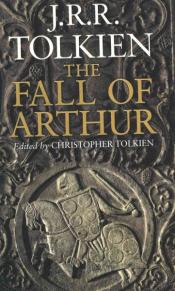
The Fall of Arthur by J. R. R. Tolkien
The Fall of Arthur recounts in verse the last campaign of King Arthur, who, even as he stands at the threshold of Mirkwood, is summoned back to Britain by news of the treachery of Mordred. Already weakened in spirit by Guinevere’s infidelity with the now-exiled Lancelot, Arthur must rouse his knights to battle one last time against Mordred’s rebels and foreign mercenaries. Powerful, passionate, and filled with vivid imagery, this unfinished poem reveals Tolkien’s gift for storytelling at its brilliant best.
Christopher Tolkien, editor, contributes three illuminating essays that explore the literary world of King Arthur, reveal the deeper meaning of the verses and the painstaking work his father applied to bring the poem to a finished form, and investigate the intriguing links between The Fall of Arthur and Tolkien’s Middle-earth.
Image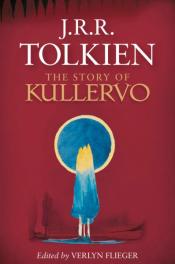
The Story of Kullervo by J. R. R. Tolkien
Kullervo son of Kalervo is perhaps the darkest and most tragic of all J.R.R. Tolkien’s characters. ‘Hapless Kullervo’, as Tolkien called him, is a luckless orphan boy with supernatural powers and a tragic destiny.
Brought up in the homestead of the dark magician Untamo, who killed his father, kidnapped his mother, and who tries three times to kill him when still a boy, Kullervo is alone save for the love of his twin sister, Wanona, and guarded by the magical powers of the black dog, Musti. When Kullervo is sold into slavery he swears revenge on the magician, but he will learn that even at the point of vengeance there is no escape from the cruellest of fates.
Tolkien himself said that The Story of Kullervo was ‘the germ of my attempt to write legends of my own’, and was ‘a major matter in the legends of the First Age’. Tolkien’s Kullervo is the clear ancestor of Túrin Turambar, tragic incestuous hero of The Silmarillion. In addition to it being a powerful story in its own right, The Story of Kullervo – published here for the first time with the author’s drafts, notes and lecture-essays on its source-work, The Kalevala – is a foundation stone in the structure of Tolkien’s invented world.
Image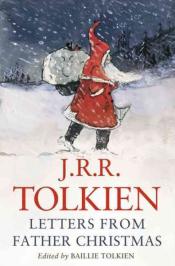
Letters from Father Christmas by J. R. R. Tolkien
Can you imagine writing to Father Christmas and actually getting a reply? For more than twenty years, the children of J.R.R. Tolkien received letters from the North Pole—from Father Christmas himself! They told wonderful stories of mischief and disaster, adventures, and battles: how the reindeer got loose and scattered presents all over the place, how the accident-prone Polar Bear climbed the North Pole and fell through the roof of Father Christmas's house, and many others.
- On Languages
- Image
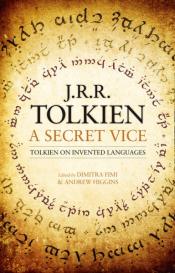
A Secret Vice: Tolkien on Invented Languages by J. R. R. Tolkien
A Secret Vice is the title of a lecture written by J. R. R. Tolkien in 1931, given at a conference. Some twenty years later, Tolkien revised the manuscript for a second presentation.
It deals with constructed languages in general, and the relation of a mythology to its language. Tolkien contrasts international auxiliary languages with artistic languages constructed for aesthetic pleasure. Tolkien also discusses phonaesthetics, citing Greek, Finnish, and Welsh as examples of "languages which have a very characteristic and in their different ways beautiful word-form".
Tolkien's opinion of the relation of mythology and language is reflected in examples cited in Quenya and Noldorin, the predecessors of Quenya and Sindarin. The essay contains three Quenya poems, Oilima Markirya ("The Last Ark"), Nieninque, and Earendel, as well as an eight-line passage in Noldorin.
- Translated Works
- Image
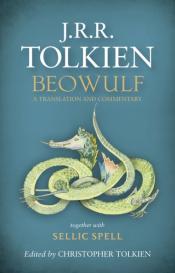
Beowulf: A Translation and Commentary by J. R. R. Tolkien
J.R.R. Tolkien completed his translation of Beowulf in 1926: he returned to it later to make hasty corrections, but seems never to have considered its publication. This edition includes an illuminating written commentary on the poem by the translator himself, drawn from a series of lectures he gave at Oxford in the 1930s.
His creative attention to detail in these lectures gives rise to a sense of the immediacy and clarity of his vision. It is as if Tolkien entered into the imagined past: standing beside Beowulf and his men shaking out their mail-shirts as they beach their ship on the coast of Denmark, listening to Beowulf’s rising anger at Unferth’s taunting, or looking up in amazement at Grendel’s terrible hand set under the roof of Heorot.